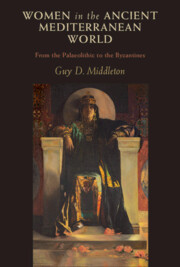Book contents
- Women in the Ancient Mediterranean World
- Women in the Ancient Mediterranean World
- Copyright page
- Dedication
- Epigraph
- Contents
- Preface
- Acknowledgements
- Timeline
- Historical Contexts
- Introduction
- Part I The Deep Past
- Part II The Bronze Age
- 4 Merneith
- 5 Šimatum and Kirum
- 6 The Woman of La Almoloya
- 7 The Priestess of Anemospilia
- 8 Hatshepsut
- 9 Puduhepa
- 10 Eritha and Karpathia
- 11 Hatiba
- Part III The Iron Age
- Part IV The Hellenistic Worlds
- Part V The Age of Empire
- Notes
- Select Bibliography
- Index
9 - Puduhepa
from Part II - The Bronze Age
Published online by Cambridge University Press: 19 January 2023
- Women in the Ancient Mediterranean World
- Women in the Ancient Mediterranean World
- Copyright page
- Dedication
- Epigraph
- Contents
- Preface
- Acknowledgements
- Timeline
- Historical Contexts
- Introduction
- Part I The Deep Past
- Part II The Bronze Age
- 4 Merneith
- 5 Šimatum and Kirum
- 6 The Woman of La Almoloya
- 7 The Priestess of Anemospilia
- 8 Hatshepsut
- 9 Puduhepa
- 10 Eritha and Karpathia
- 11 Hatiba
- Part III The Iron Age
- Part IV The Hellenistic Worlds
- Part V The Age of Empire
- Notes
- Select Bibliography
- Index
Summary
The Hittite state started small, as one of a number of competing kingdoms in Anatolia.1 Under a series of rulers from the early king Hattusili I, around 1650 bc, it grew to become a regional superpower, expanding from its north-central Anatolian heartland, with political and economic interests drawing its attention southeast to the Mediterranean coast, Syria, and the older kingdoms in the area, and also westward to the Aegean.2 Its capital at Hattusa, the fortified residence of the Hittite kings, modern Boğazköy, became a splendid city of temples, testament to the rulers’ commitment to the gods and the rituals necessary to win their favour and avoid incurring their displeasure.3
- Type
- Chapter
- Information
- Women in the Ancient Mediterranean WorldFrom the Palaeolithic to the Byzantines, pp. 89 - 94Publisher: Cambridge University PressPrint publication year: 2023

